More than 300 lighting industry leaders gathered in Chicago July 13–15, 2009, for the fourth annual Solid-State Lighting (SSL) Market Introduction Workshop, hosted by the U.S. Department of Energy (DOE) and the Midwest Energy Efficiency Alliance (MEEA). This annual workshop provides a focal point for government, industry, energy efficiency organizations, utilities, municipalities, designers, specifiers, retailers, distributors, and others to share updates and insights on the successful market introduction of high-quality, energy-efficient SSL solutions.
Separating Fact from Fiction
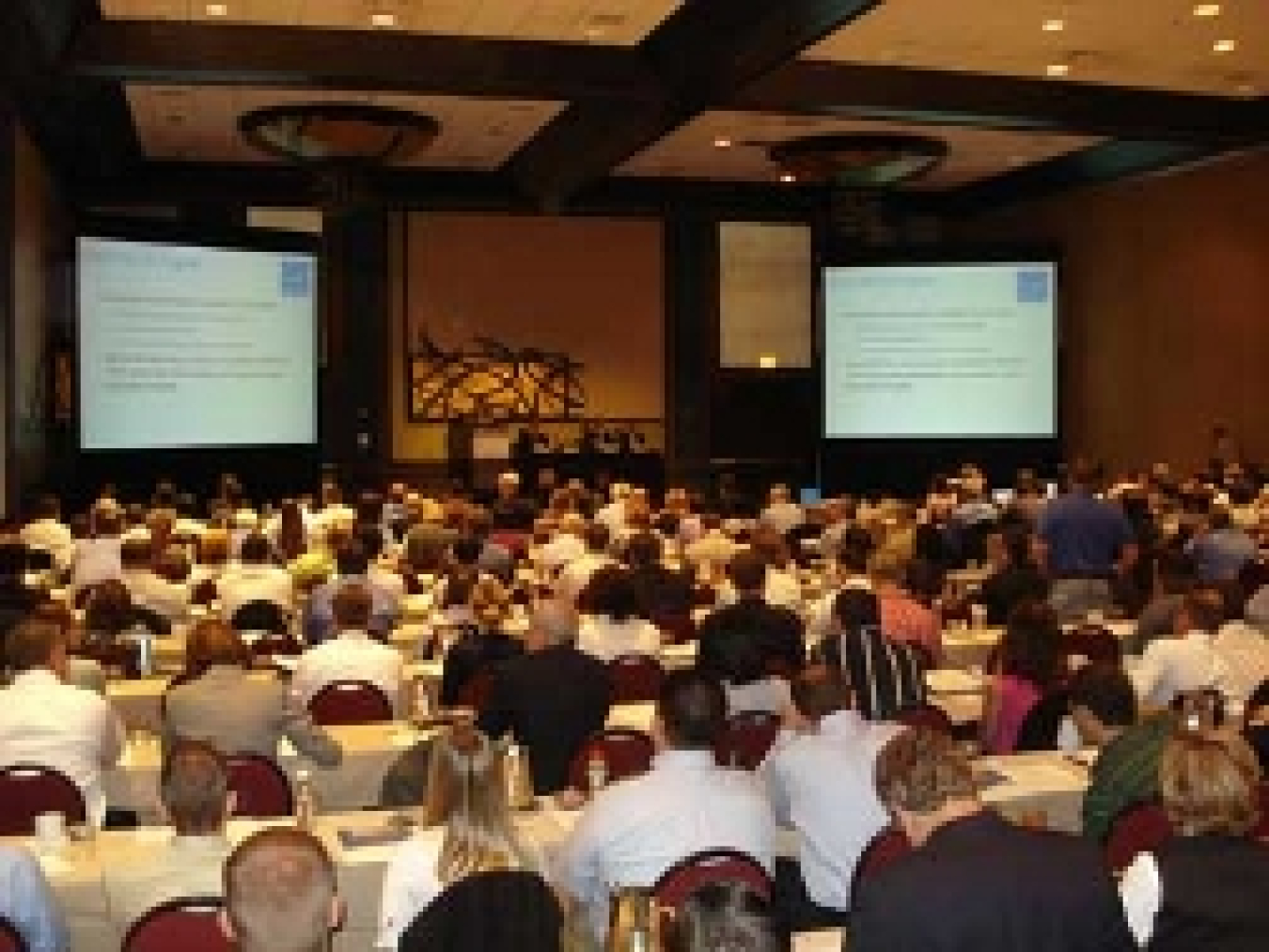
More than 300 attendees gathered in Chicago for the fourth annual workshop.
Day 1 of the Chicago workshop was devoted to tutorials that provided a solid basis for understanding the basics of SSL and laid the groundwork for the panels and presentations that would follow on Days 2 and 3. Presented by representatives from DOE, Pacific Northwest National Laboratory (PNNL), and D&R International, these tutorials introduced DOE's market-based SSL programs—including CALiPER testing; GATEWAY demonstrations; Quality Advocates; ENERGY STAR® for SSL; standards support; and the Lighting for Tomorrow, Next Generation Luminaires™ and L Prize™ competitions. The afternoon concluded with a review of appropriate applications for LED lighting and examined the issue of why measuring fixture efficacy provides a more accurate performance measure than source efficacy. The tutorials were followed by an optional walking tour that provided behind-the-scenes, firsthand looks at several LED installations in downtown Chicago, including the Merchandise Mart and the Wit Hotel.
DOE SSL Portfolio Manager James Brodrick and MEEA Executive Director Wendy Jaehn kicked off Day 2 of the workshop. Jaehn welcomed attendees to Chicago and observed that "this technology is changing so rapidly that what is relevant today may not be relevant tomorrow." Brodrick noted the widespread confusion surrounding the rapidly evolving SSL market and underscored the need for reliable information to help "separate fact from fiction." He reviewed DOE's SSL program strategy, key partnerships, and market-based programs.
Mark McClear of Cree Inc. gave a keynote address on the status of the LED lighting revolution, asking (and answering) the age-old question: "Are we there yet?" He concluded that some groups are "there" and others are not, and he stressed the importance of education to facilitate the process. McClear noted that while having quality LEDs is crucial, it's not sufficient in and of itself, because the other luminaire components have a direct impact on overall product quality and performance.
Sorting Wheat from Chaff
McClear was followed by a panel on assessing LED products, which was composed of Richard Karney of DOE, Scott Riesebosch of CRS Electronics, and Ron Steen of Xicato. The panel was moderated by Brodrick, who noted SSL's energy-saving potential and reviewed ways DOE can help the industry avoid the mistakes that delayed the market introduction of compact fluorescent lamps (CFLs) in the 1980s and '90s. Brodrick urged attendees to join as Quality Advocates and use the Lighting Facts label as a guide to ensure the products they are considering have been tested to appropriate industry standards. He also recognized the market-ready winning products from the Next Generation Luminaires competition.
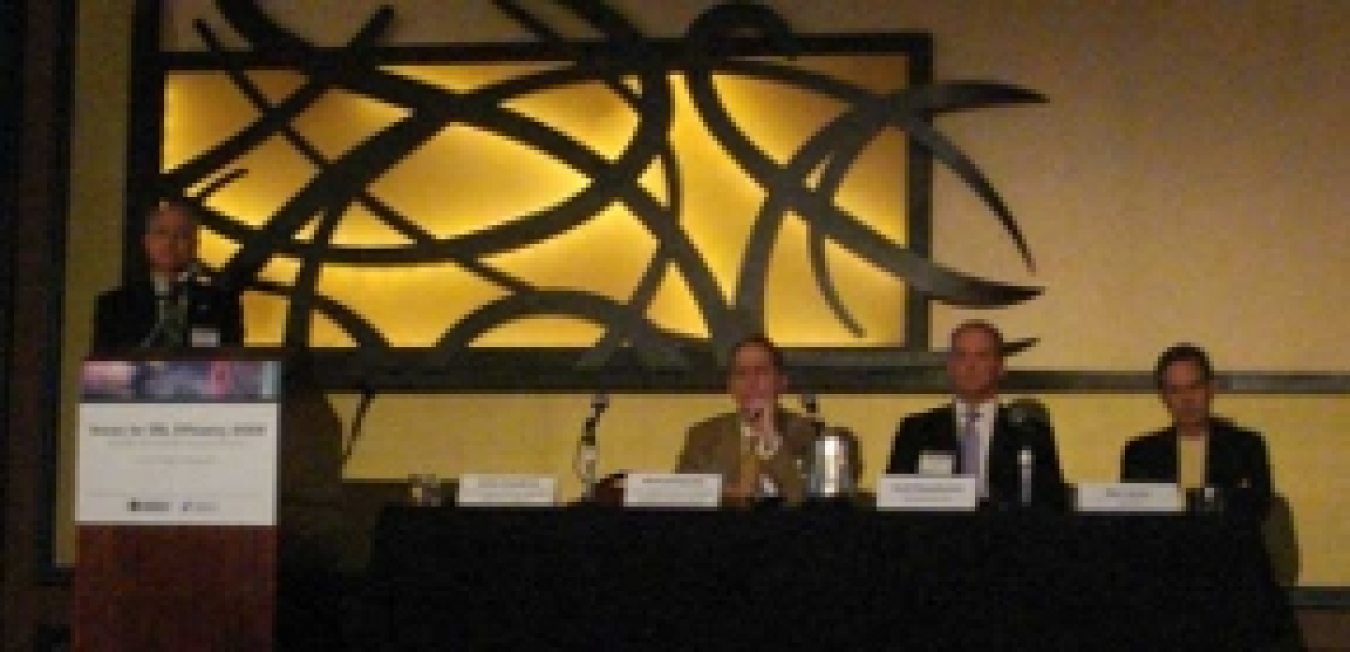
Panelists offer varied perspectives on evaluating today's LED products.
Karney gave an overview of the ENERGY STAR program for SSL, detailing the applications covered by the current criteria and draft criteria in development. He offered a snapshot of progress to date: 127 current manufacturer partners, 28 qualified products (with just as many in the queue), and 6 running program promotions (with 9 in the planning stage). Riesebosch stressed that "all LEDs are not created equal" and noted the importance of reliable technical data in assessing SSL products. He urged attendees to ask for IES files and LM-79 test results and to look at the total cost of ownership rather than just first cost. Steen shared an overview of color variation among white LEDs, noting the importance of considering the color sensitivity of various applications and getting color maintenance data from the manufacturer.
A panel on marketing LED lighting products followed, moderated by Shana Cockerham of D&R International. The panel consisted of Tom Harold of Grainger and Bill Hamilton of The Home Depot. Cockerham noted that retailers and distributors play a key role because they are the last group to interact with consumers before the purchasing decision is made. Harold discussed the lessons his company learned from CFLs and described current issues with some LED products (poor light output, exaggerated lifetimes, and poor or inconsistent color quality). But he mainly focused on DOE's Quality Advocates program and how "it ultimately will drive faster market adoption of LED technology in general" by helping to ensure that products are accurately represented. Hamilton said LEDs "are coming like a freight train" and will eventually replace incandescent bulbs because of the energy savings. But he noted that consumers' high expectations for SSL need to be brought down to reality and called for improved product quality and consistency.
Next, Deanna Matthews of Carnegie Mellon University gave a snapshot of the progress to date in the DOE SSL Life Cycle Assessment study, which is looking at all of the materials and energy resources required for SSL products over their entire life cycle. She observed that for LED products (as well as for incandescent lamps and CFLs), energy used for production appears to be small relative to energy used over the life of the product. However, as LEDs become more efficient, lifecycle energy use by LEDs will fall as production energy becomes a larger fraction of the lifecycle total.
Transforming the Market—Carefully
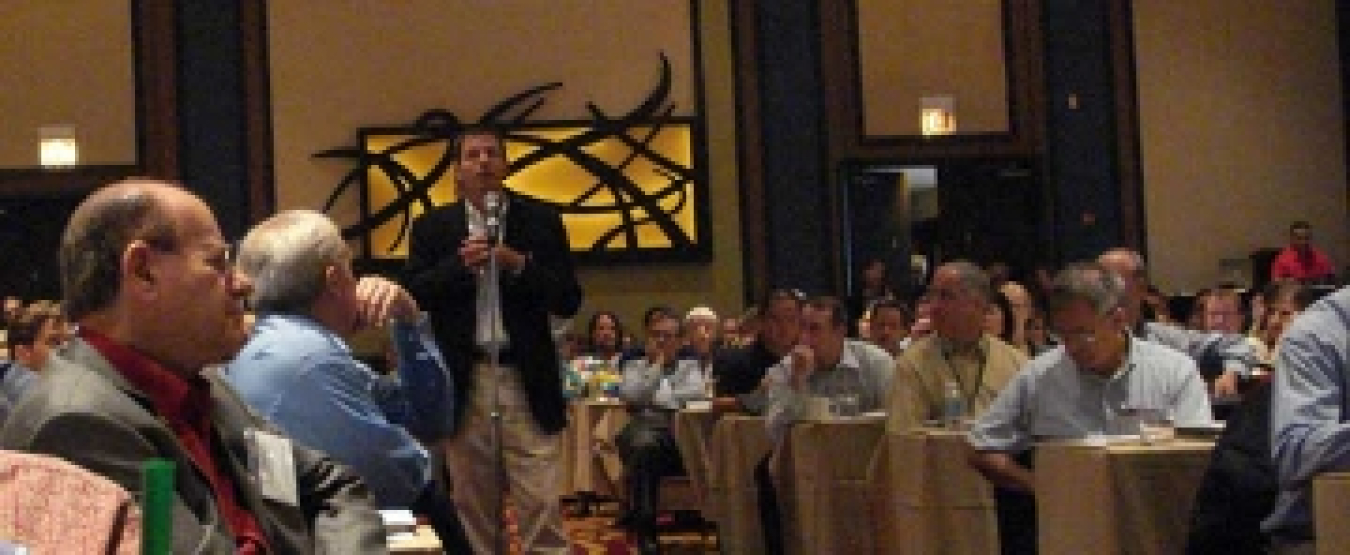
Questions from attendees spark further discussion.
Matthews was followed by a panel on strategies and best practices for implementing LED lighting incentive programs, moderated by Chad Bulman of MEEA. The panel consisted of Mark Hamann of ComEd, Kelly Cota of National Grid, Liesel Whitney-Schulte of Wisconsin Energy Conservation Corp., Robert Gibson of National Rural Electric Cooperative (NREC), and Martha Carney of Outsourced Innovation. Hamann cautioned that SSL could potentially be a "perfect storm for energy efficiency programs" because of the combination of high interest in the technology, a good number of poor-quality products on the market, and limited standards and specifications to guide customers. He said ComEd is closely monitoring the technology through DOE's SSL initiative. Cota discussed National Grid's retrofit and new construction initiatives for LED downlights, as well as a performance lighting initiative for new construction and extensive renovation projects. "We feel we can help transform the market, the more incentives we offer," she said.
Whitney-Schulte discussed some SSL incentives offered by Wisconsin's Focus on Energy initiative but also noted the challenges, including a limited list of ENERGY STAR-qualified products, long paybacks, and huge variation in quality among products. "We want to make sure that these products are really going to deliver what the customers are expecting," she said. Co-presenters Gibson and Carney discussed the use of SSL incentives by electric co-ops in rural areas, especially for dusk-to-dawn security lighting, agricultural applications, and community and commercial use, and reviewed the results of an SSL parking lot demonstration.
More on Outdoor Lighting
Michael Barber of the City of Anchorage, Alaska; Scott Wentworth of the City of Oakland, California; and Ralph Williams of Walmart took part in a panel on outdoor street and area lighting, moderated by Jason Tuenge of PNNL. Barber described Anchorage's experience in beginning a three-phased plan to retrofit its streetlights to SSL, which is projected to cut energy use by 50 percent and save $350,000 annually, with a seven-year payback period. He described a myriad of planning considerations (e.g., Who owns the lights? Who is responsible for retrofits? How do you depreciate the new hardware? How do controls and dimming strategies affect the maintenance schedule?) and shared details of their rigorous fixture specification: tool-less entry for maintenance and installation; modular design; minimum warranties on LEDs, driver, paint, and finish; LM-79 and LM-80 tested; and more.
Wentworth said that city engineers want to deliver optimal systems and noted they must meet their primary goal—safety—while minimizing risk for the municipality. He recounted Oakland's experience with an LED street lighting demonstration, conducted in three phases with increasingly positive results. He then described his view of a next-generation street lighting system, featuring increasingly efficient sources, maintenance predictors, innovative warranties, lumen maintenance with auto shut-off, utility grade metering, late-night dimming, and more.
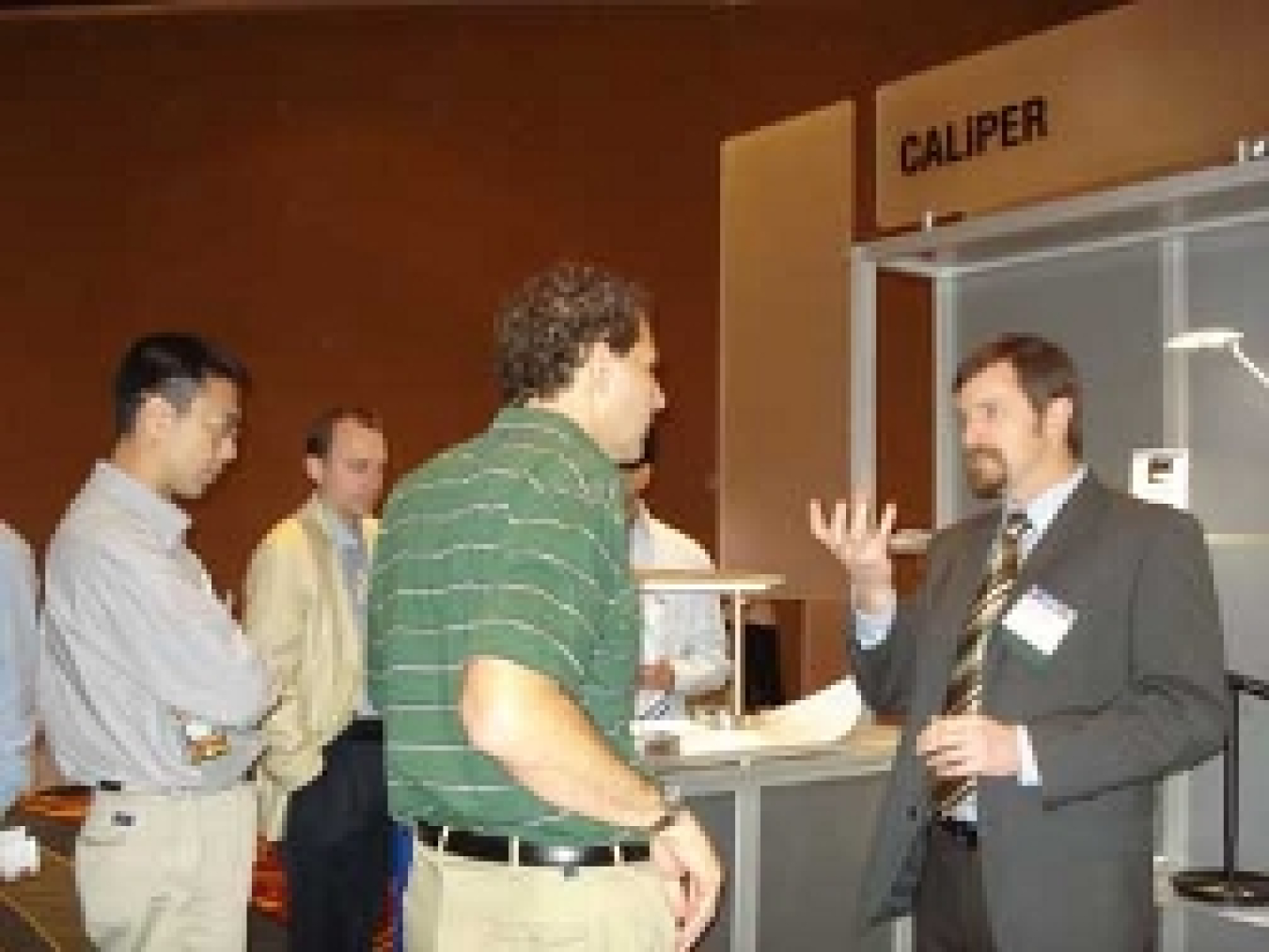
Attendees learn more about CALiPER testing during a break.
Williams discussed the results of Walmart's first full-site evaluation of SSL in the parking lot of a supercenter using the LED Site Lighting Performance Specification developed by the DOE Commercial Building Energy Alliances. In this demonstration, Walmart found that LED lighting is more uniform and controllable than metal halide, reduces site energy use by more than 65 percent for annual savings of $11,500, and requires less maintenance. Despite the encouraging results, Williams cautioned that individual store geometry, local ordinances, and acquisition costs all factor into determining whether SSL is the right solution for a given location. Tuenge then reviewed the ENERGY STAR draft criteria for outdoor SSL luminaires and described a new efficacy metric developed by DOE for evaluating outdoor area and roadway lighting. The Fitted Target Efficacy (FTE) metric gauges a luminaire's performance independent of a specific application and provides a more meaningful metric that differentiates useful lumens from those that may cause glare, wasted light, or light trespass.
Designing with LEDs
Day 3 of the workshop began with a panel on designing with LEDs, which was moderated by Marsha Turner of the International Association of Lighting Designers. The panel was composed of Derry Berrigan of Derry Berrigan Lighting Design, Dan Blitzer of the Practical Lighting Workshop, Avraham Mor of Lightswitch Architectural, and Emily Klingensmith of Schuler Shook.

Lighting designers share insights on using today's LED products.
Blitzer spoke about LED luminaires in various applications, comparing LED technologies to conventional technologies in terms of application efficacy, color, lifetime, and other factors. He noted that LEDs tend to perform well in applications where they are close to the target, the environment is cool, the lighting requirement is modest, or there are no conventional options that can compete with the small size, dimmability, or other unique attributes of LED technology. Mor discussed designing with LEDs, comparing the pros (e.g., longer life, less design maintenance) with the cons (e.g., flicker, high cost, lack of installer and manufacturer knowledge). He offered candid advice to component and luminaire manufacturers and detailed his firm's stringent requirements of SSL vendors (e.g., LM-79 photometry, multiple samples of the same CCT, written luminaire binning policy and end-of-life policy, and warranty on all system components). Mor strongly encouraged manufacturers to join DOE's SSL Quality Advocates and to qualify their fixtures for ENERGY STAR, arguing that doing so made it much easier for him to assess and consider use of their products.
Klingensmith presented case studies of three installations where she considered LED lighting solutions, describing the real-world constraints that influence decisions about using LEDs in a given application. In one application, the LED solution was simply too costly to illuminate 290 linear feet of graphics panels. For the second application, LEDs won out by providing more uniform light distribution in wall-to-ceiling light boxes. LEDs were the only solution considered for the third application, involving display niches in an outdoor memorial. Berrigan described her use of LED lighting in a Walmart prototype store, noting that she is currently involved in a study to assess the effects of LED lighting on the shelf life of grocery produce. She also discussed a project in which she replaced most of the lighting in a McDonald's restaurant with LEDs; her focus was to eliminate overlighting and deliver light only where it is needed. "What this project shows is that we can maintain lighting quality, attain energy efficiency, and do it in a cost-effective, practical way," she said. "This is the future."
LED Reliability
An LED reliability panel followed, moderated by Eric Richman of PNNL and featuring Mark Hodapp of Philips Lumileds Lighting Co. and Steven Briggs of GE Lumination. Richman gave a brief overview of the issue, making the point that historically, reliability has been assumed to be covered by lamp life, but that the potential long life of LEDs forces consideration of other components, such as drivers and electrical circuitry, as well as careful thermal design. He shared a number of observations from reliability testing being conducted through the DOE CALiPER program.
Hodapp talked about designing LED products for reliability, detailing Philips' efforts to gain an enhanced understanding of LED lumen maintenance and catastrophic failures through reliability modeling that looks at the effects of temperature, drive current, and other factors. He concluded by noting that "overall system reliability is only as good as the weakest link" in the entire system. Briggs emphasized the need to consider both the product and the process when designing LED luminaires for reliability and to learn from failures to determine their root cause. He defined a successful approach as including such things as comprehensive and measurable specification, modeling and design simulations, and execution of the verification and validation plan on an adequate sample size.
The Cost Factor
The workshop concluded with a panel on cost effectiveness, which consisted of Bruce Kinzey of PNNL; Dan Weinheimer of the City of San Marcos, California; and Chris Granda of Vermont Energy Investment Corp. The panel was moderated by Brodrick, who gave a brief overview of the issue, noting that high costs remain the biggest hurdle to market acceptance of SSL. He emphasized there are multiple factors in addition to first cost that can affect decision-making: energy savings (relative efficacy compared to the incumbent technology), maintenance savings (particularly in applications where maintenance is costly or difficult), incentives or rebates, and the site owner's specific financial criteria.
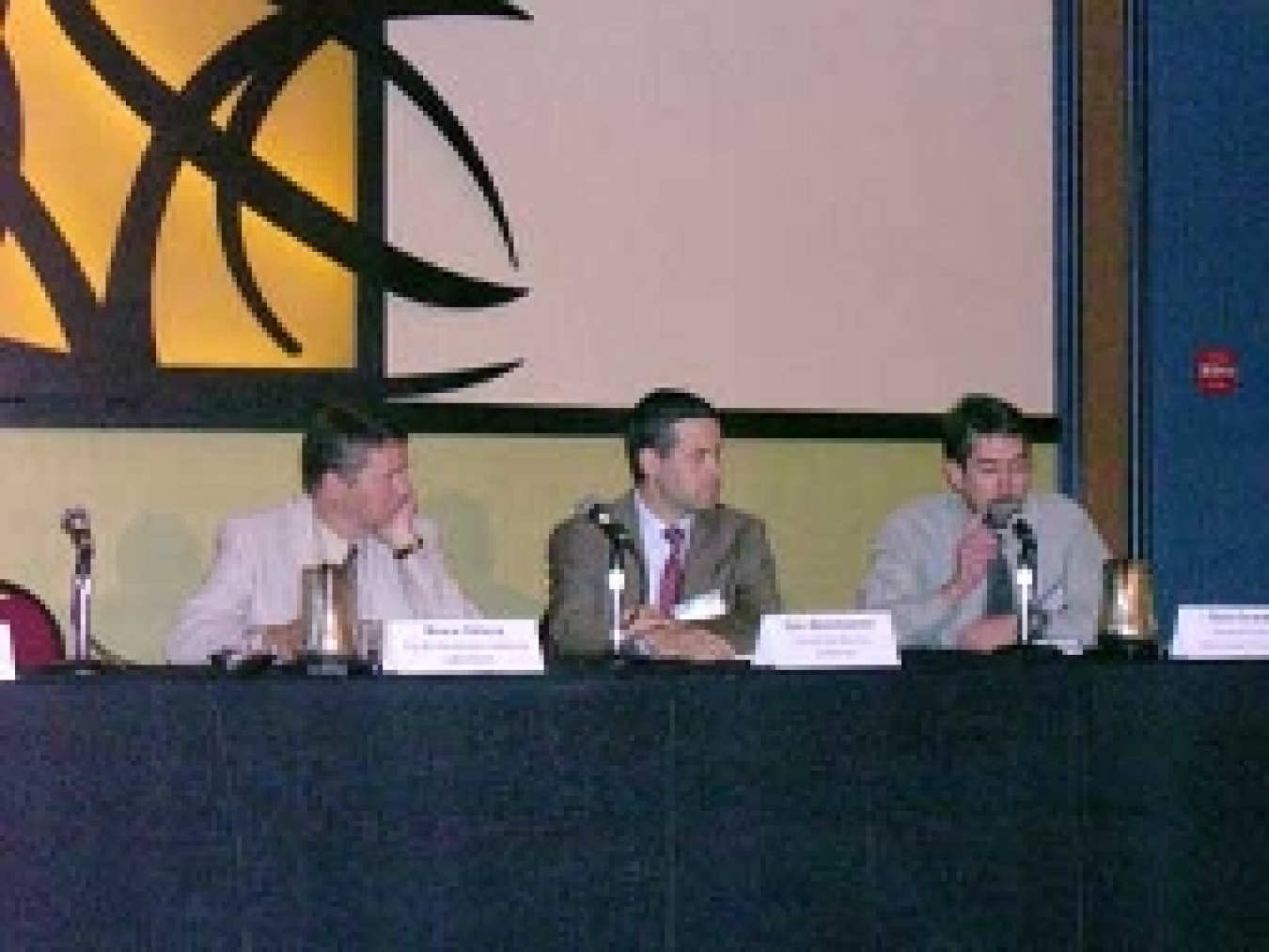
Panel session on cost-effectiveness of LED lighting solutions.
Kinzey stated that energy savings by itself is insufficient motivation for much of the market and that there is an increasing need to identify and quantify the value of the other benefits of SSL, such as longer life, reduced maintenance, superior control, and other advantages that have yet to be determined. He shared perspectives gained from the DOE GATEWAY demonstration program, noting that cost effectiveness is typically heavily influenced by maintenance savings, which are typically much greater than energy savings.
Drawing on the pilot study of LED street lighting that San Marcos is conducting, Weinheimer cautioned that not all products are equal and advised other municipalities to test each product before making major purchases, to secure long and comprehensive warranties, and to develop studies to indemnify local government. Granda presented the utilities' point of view, focusing on how energy efficiency program sponsors decide whether an energy-efficient product is cost effective. He offered an economist's point of view, using the total resource cost test to compare a metal halide outdoor lighting solution with an LED solution, and applying this same test to assess what a cost-effective L Prize bulb should cost.
Brodrick concluded the three-day workshop with an invitation to partner and participate with DOE and urged attendees to stay abreast of a market in motion.
